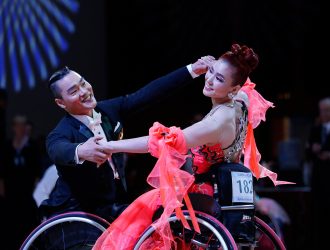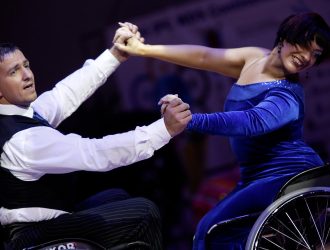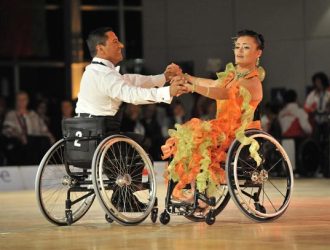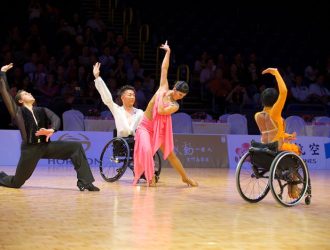Wheelchair Dancesport
Wheelchair DanceSport is a partner dance competition and Dancesport where at least one of the dancers is in a wheelchair.
Sport#
Wheelchair couple dances are for two wheelchair users or for one wheelchair user with a “standing” partner and include standard dances such as waltz, tango, Viennese waltz, slow foxtrot and quickstep and Latin American dances such as samba, Cha Cha Cha, rumba, paso doble and jive. There are also formation dance for four, six or eight dancers.
Wheelchair dancing started in Sweden in 1968, originally for recreation or rehabilitation, with the first competition held in 1975. The first international competition was also held in Sweden, in 1977. Several regional and international competitions followed and the first World Championship was held in Japan in 1998. Since 1998, Wheelchair DanceSport is governed by the International Paralympic Wheelchair Dance Sport Committee (IPWDSC), although it is not part of the paralympic program. The sport incorporates the rules of the World DanceSport Federation (WDSF).
Championships#
Classification#
- Combi: dancing with an able-bodied (standing) partner
- Duo: dance for two wheelchair users together
- Formation: dances for four, six or eight couples dancing in formation
athletes are placed into one of two classes:
- LWD 1: 14 points or less
- LWD 2: more than 14 points
Social#
Wheelchair dancing is a popular social and recreational activity, with participants in over 40 countries. The physical benefits of wheelchair dancing include the maintenance of physical balance, flexibility, range of motion, coordination and improved respiratory control. The psychological effects of ballroom dancing are social interaction and the development of relationships. For social dancers, it is an opportunity to engage in a fun and a friendly event with others. For competitors, it assists in the development of fair play, sportsmanship and communication skills. Wheelchair dancing is an activity that integrates the wheelchair user and able-bodied person. During the Baroque Era, dancing at court balls was a display of social status. A formal ball opened with a branle, in which couples stood in a line in order of their place in the social hierarchy. The most highly regarded couples would dance first. Some of the couple dances included the Menuet and the Gavotte. Once all couples had danced, the attendees would end the ball with popular English countryside dances, called Contredanses. The French Revolution in 1789 created a shift toward less courtly, rigid social dancing.
Courses#
In February, 2008 the University of Delaware Collegiate DanceWheels Program was created to instruct students in wheelchair dancing. This is the first accredited course of its kind in the United States. The program was developed in conjunction with the American DanceWheels Foundation through a grant from the Christopher and Dana Reeve Foundation.





